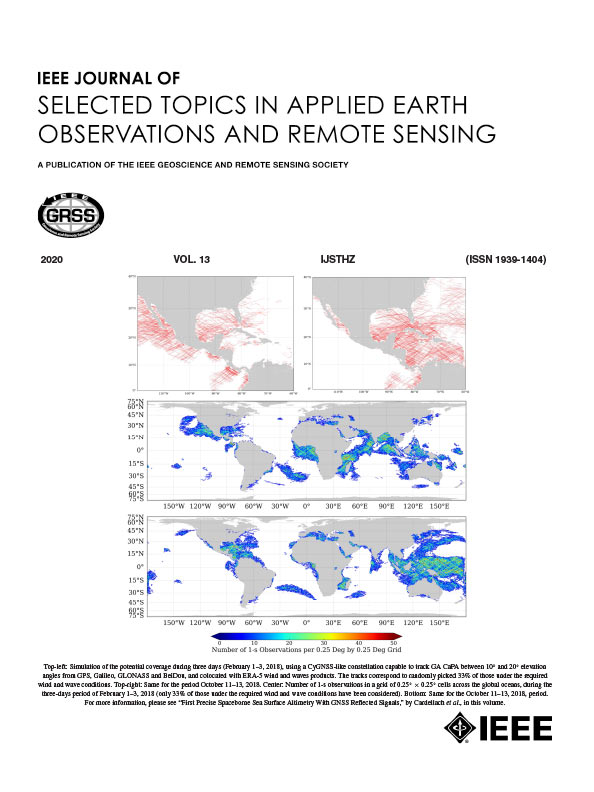Assessment of Urban and Peri-Urban Green Infrastructure Patterns Using Morphological Spatial Pattern Analysis and Satellite Imagery: Case Studies of Braşov and Oradea, Romania
IF 5.3
2区 地球科学
Q1 ENGINEERING, ELECTRICAL & ELECTRONIC
IEEE Journal of Selected Topics in Applied Earth Observations and Remote Sensing
Pub Date : 2025-09-26
DOI:10.1109/JSTARS.2025.3614809
引用次数: 0
Abstract
Sustainable urban development requires a detailed understanding of green infrastructure (GI) and its spatial patterns. Urban growth can occur within existing urban areas or through expansion into peri-urban zones. Maintaining a high percentage of GI contributes to well-being by regulating microclimatic parameters, reducing air pollution, decreasing urban noise, and supporting public health by providing access to functional green spaces. This study aimed to assess the GI patterns in the urban and peri-urban areas of two Romanian cities, Braşov and Oradea, using morphological spatial pattern analysis (MSPA). Data for evaluating GI patterns were derived from multitemporal Sentinel-1 (S-1) and Sentinel-2 (S-2) satellite imagery, alongside vegetation indices (NDVI, EVI, NDBI, SAVI, and NDWI). Classification was performed into seven land use/land cover (LULC) classes using the gradient tree boosting machine learning algorithm, achieving overall accuracies of 96.02% for Braşov and 95.67% for Oradea. The LULC categories were reclassified into foreground (forest, grassland, cropland, and water) and background (built-up, uncultivated, and bare land). Seven MSPA classes (core, edge, bridge, branch, islet, perforation, and loop) were evaluated to measure GI’s morphological patterns, and Gini coefficients were calculated to assess GI equity. Results showed that Braşov had a moderately equitable GI distribution (0.325) in urban and peri-urban areas, while Oradea displayed a more unequal distribution (0.519). Core areas represented the largest spatial extent in both cities, with Braşov covering 73.1% (urban) and 84.1% (urban and peri-urban), while Oradea covered 59.0% (urban) and 66.5% (urban and peri-urban). The GI edge pattern in Oradea was more complex, indicating higher fragmentation.基于形态空间格局分析和卫星图像的城市和城郊绿色基础设施格局评估:以罗马尼亚bra ov和Oradea为例
可持续城市发展需要对绿色基础设施及其空间格局有详细的了解。城市增长可以在现有的城市地区内发生,也可以通过向城市周边地区扩张而发生。通过调节小气候参数,减少空气污染,减少城市噪音,并通过提供功能性绿色空间来支持公众健康,保持高比例的地理特征有助于人们的福祉。本研究旨在利用形态空间格局分析(MSPA)对罗马尼亚两个城市bra诺夫和奥拉迪亚的城市和城际地理特征进行评估。GI格局评价数据来源于Sentinel-1 (S-1)和Sentinel-2 (S-2)卫星影像,以及植被指数(NDVI、EVI、NDBI、SAVI和NDWI)。使用梯度树增强机器学习算法将土地利用/土地覆盖(LULC)分类为7个类别,bra的总体准确率为96.02%,Oradea的总体准确率为95.67%。将LULC分类重新划分为前景(森林、草地、农田和水域)和背景(建成区、荒地和裸地)。评估7个MSPA类别(核心、边缘、桥、支、岛、穿孔和环)来衡量GI的形态模式,并计算基尼系数来评估GI公平性。结果表明,brauceov在城市和城郊的GI分布较为公平(0.325),而Oradea的GI分布较为不平等(0.519)。两个城市的核心区空间面积最大,其中布拉迪斯拉发的核心区面积为73.1%(城市)和84.1%(城市和城郊),而奥拉迪亚的核心区面积为59.0%(城市)和66.5%(城市和城郊)。奥拉迪亚地区GI边缘格局较为复杂,破碎化程度较高。
本文章由计算机程序翻译,如有差异,请以英文原文为准。
求助全文
约1分钟内获得全文
求助全文
来源期刊
CiteScore
9.30
自引率
10.90%
发文量
563
审稿时长
4.7 months
期刊介绍:
The IEEE Journal of Selected Topics in Applied Earth Observations and Remote Sensing addresses the growing field of applications in Earth observations and remote sensing, and also provides a venue for the rapidly expanding special issues that are being sponsored by the IEEE Geosciences and Remote Sensing Society. The journal draws upon the experience of the highly successful “IEEE Transactions on Geoscience and Remote Sensing” and provide a complementary medium for the wide range of topics in applied earth observations. The ‘Applications’ areas encompasses the societal benefit areas of the Global Earth Observations Systems of Systems (GEOSS) program. Through deliberations over two years, ministers from 50 countries agreed to identify nine areas where Earth observation could positively impact the quality of life and health of their respective countries. Some of these are areas not traditionally addressed in the IEEE context. These include biodiversity, health and climate. Yet it is the skill sets of IEEE members, in areas such as observations, communications, computers, signal processing, standards and ocean engineering, that form the technical underpinnings of GEOSS. Thus, the Journal attracts a broad range of interests that serves both present members in new ways and expands the IEEE visibility into new areas.

 求助内容:
求助内容: 应助结果提醒方式:
应助结果提醒方式:


